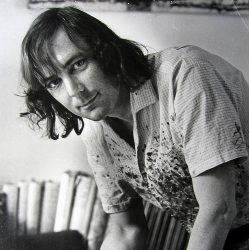“In the late 60s, Lea Feinstein encountered John Cage’s theory of chance operations at a New York performance of Merce Cunningham’s Dance Company. Her technique and approach to art were shaped by that encounter. Her approach to color was influenced by the works of Helen Frankenthaler and Sam Gilliam, at the Corcoran School of Art in Washington, DC. Current influences are the paintings of Pat Steir, Brice Marden, and David Reed—a fellow student at Skowhegan School of Painting and Sculpture. Lea has taught design at CCA, Rhode Island School of Design, Maryland Institute College of Art, George Washington, and Georgetown University. She writes for ArtNews Magazine and Artpractical.com– a new San Francisco art blog– and is the author of numerous articles and catalog essays. She has just completed a chapter on Edvard Munch in Oslo, for the guidebook series Art + Travel (www.museyon.com).”
more….
I met my soon-to-be-husband Carl Feinstein at Skowhegan during the summer of 1966, where I also met Marshall Baron. (It was the summer between junior and senior year at Wellesley College, and I had heard about Skowhegan from Sigmund Abeles, my teacher there. ) Carl and Marshall had long talks about music and the Vietnam war, and I had long talks with Marshall about painting, music, and sculpture. I was doing a lot of figure drawing and figure sculpture, and was deeply into modern dance. Many of the male students at Skowhegan expected to be drafted, and had transferred their induction physicals from NY to Bangor, Maine. They fasted and smoked marijuana and went to their physicals totally spaced, and flunked them. Every Saturday we had day-long crits by visiting NY artists: Larry Rivers, Isabel Bishop, Gabe Laderman. Elmer Bischoff and Kenneth Callahan were the artists in residence. Powerful experiences, and a guaranteed head ache at the end of the long day.
Strong memory: Marshall standing on his head every morning at the end of the dock jutting out into Lake Wesserunsett as the sun rose. It must have been his meditation, for he stood on his head for a long time. And I remember his easy laugh, his Rhodesian accent and the extraordinary clarity of his blue eyes. It was a very serious group there that summer. The war was raging, and everything was at stake. But maybe when you are young, everything is ALWAYS at stake.
Why I painted the Marshall Baron variations: I had met Saone Crocker, a young mother and friend of a friend, Jenny Oliver in Washington, DC. I asked her where she was from. She said Bulawayo, Southern Rhodesia. I said, Oh I know someone from Bulawayo. His name is Marshall Baron. Shrieks! He’s my brother. Then when Marshall visited Saone in DC, he also visited us. Those visits were more somber, but still lovely.
When Saone called to say that Marshall had died, she said “He told me that if he had married, he would like to have married someone like you.” I was dumbstruck. Went to my attic studio, and tried to connect with Marshall somewhere in the great beyond. Just thinking and thinking about him. Perhaps we had all listened to the Goldberg Variations on our last visit. I had been doing abstract torn paper collages in a color class I was taking, a big departure from my figurative work. So I began to make a series of dark, India ink washes (my way of mourning) on top of my color collages. And thinking of them with an underlying grid structure. Maybe it was the idea of musical theme and variation…but I promised him that I would make a lot…so I began. Next morning our English live-in babysitter who slept in our basement apt. said that her rocking chair had begun to rock in the middle of the night. I thought to myself “Marshall made a mistake. I was on the top floor, not the bottom floor. He should have come upstairs.” He was the most deeply spiritual person I had met to date…..and I was sure if I could have communicated to anyone by spirit, it would have been Marshall.
I worked on the themes in the Marshall Baron Variations for the next several years—mix of collage and dark wash, in grid-like patterns. I exhibited them in 1979 at the Georgetown Art Gallery, along with my series of bronze and clay heads, and many of them sold. At a subsequent show at Gallery K in Alexandria the following year, more sold. I have no record of many of these. But I know one has been passed down from mother (Jane Loeffler Cantor) to her son as a wedding gift. They call it “the pink condo” and it hangs over the fireplace in their new home. I am tickled, and I know Marshall would be too.
As I look at my current work, and back at what Marshall was painting when I first met him, I realize that he helped me make the leap into abstraction. The flowing forms that are seminal to my current work are everywhere in his painting, although I paint in acrylic on tyvek, and he painted mostly in oil on canvas. I work at a big scale that he would approve of. I still talk to him, and he still answers.

